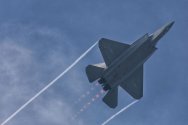That "F-35" style was used by FC-31 v1 (31001), later version v2 and J-35 does not use it. From the look it seems to me that J-35A does not use it either. If this style has some big advantage, why would v2 and J-35 turned away from it?
The design addressed the bulkiness of Flanker's implementation, but did not argue whether this design is limited to installation like 31001/F-35 style.
[add] I aknowledge that Flankers have the same style as 31001/F-35, and look at the diagram it seems it can only be mounted in such manner.
View attachment 139143
I would beg to differ concerning the point that this hinge design will not be used on the J-35A, but as of right now none of us know which one (if any) of the 2 jets currently at Zhuhai is the LRIP one, so probably we just need to wait a bit. The way I see it, the pivot design that 31003, the naval variant and one of the J35As uses is more of a low risk, low potential reward solution that is quick and easy to implement, while the hinge design that first appeared on 31001 and later (probably improved, but I’m just guessing) on the other J35A seems to be something more novel and has advantages if done well.
Also, that research paper excerpt states that the 2 horizontal tail designs depicted (one apparently for 31001 and the other for flanker) are different styles, so not 100% sure what you meant by the last paragraph.
edit: just checked and the paper from Wang Xiangming that we both quoted is from 2020, well after the time of 31001 so it’s pretty safe to assume that it’s either completely new or an improvement upon 31001’s hinge-type horizontal tail. The timing also might explain why it’s not on the naval variant and possibly even one of the shown J35As. Hear me out:
By 2020 the naval variant should be already pretty far into its design phase, possibly having had its design finalized and having started production of the first prototypes, which meant that Shenyang would be hard-pressed to incorporate this new design element into the model, especially if the Navy is in a bit of a hurry to get things going and to acquire their own 5th gen jets, which we can pretty confidently assume they are.
As to the J35A with the pivot-type horizontal tail, I have only guesses. Currently my head canon is that that particular jet is an earlier (possibly even the first) prototype for the Air Force variant, and was somewhat rushed out to start flight testing and validating design elements not concerning the horizontal tail design (e.g. the new 3D printed wing spars without the folding mechanism). If at the start of this prototype’s building phase the new tail hasn’t yet been finalized then it makes at least some sense that the design team would just simply reuse the naval variant’s horizontal tail to save some time. I cannot explain why the same design change is not present on the naval variant, but maybe that’s due to customer request, or some obscure advantages/disadvantages of either design in edge cases, or some other reason that I cannot guess.
Anyways, having said all that, this is only my own take on the issue and is clearly far from totally convincing or without flaw. I’m happy to discuss and to admit Im mistaken if that should turn out to be the case.



